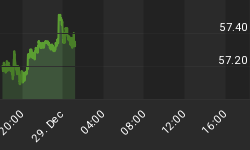Goldilocks is the term used by Wall Street to describe a nearly perfect environment for stock values to rise. The term is being used again today, just as it was mistakenly uttered in the middle of the housing bubble, to express the belief held by most investors that we have once again reached equity-market nirvana--a point in time where virtually every economic condition is just right.
However, what Wall Street regards as a nearly perfect economic environment is really just another misinterpretation derived from believing money printing, artificial interest rates, debt and asset bubbles can provide sustainable growth.
This same miscalculation occurred when Ben Bernanke first took the helm of the Federal Reserve on February 1st 2006. At that time, former Chairman Alan Greenspan had already slowly and steadily taken the Fed Funds Rate up to 4.5%, from the 1% level back in June of 2003. The newly appointed Bernanke followed Greenspan's lead and continued to hike the Fed Funds rate three more times in .25% increments. By June of 2006 the Funds Rate was at 5.25% and the Ten-Year Note climbed from 4.5% in February, to 5% by June.
Rising interest rates seemed completely innocuous back then, just as they do today. In fact, the higher borrowing costs were being heralded as a sign that the Fed believed stronger growth was in store; and Wall Street cheered Bernanke and the goldilocks economy on. We all know in hindsight that the 5% Ten-Year Note yield was enough to collapse the entire real estate market, banking system and economy. Because of the lofty debt levels, all it took to kick start the Great Recession was a 10-Year Note that yielded just 5%.
The truth, which belied Wall Street's ebullience, was that the massively overleveraged private sector was teetering on collapse. And when the interest rate trigger was pulled, the economy fell apart. At the end of 2007 the aggregate level of debt in the economy was $49 trillion, or roughly a staggering 330% of GDP.
That aggregate level of debt has now surged to $55.5 trillion at the end of 2013, which is still about 330% of our economy. We have not deleveraged at all. In fact, the nominal level of debt has exploded by over $6 trillion. This onerous level of debt is merely being masked by low interest rates and an unstable economy that is being levitated by producing renewed asset bubbles. An overleveraged consumer and banking sector-which was the case in 2007--is certainly not a more beneficial condition than having an insolvent government. Once interest rates rise it will again reveal the fragile state of the economy.
There hasn't been any structural reforms made to this economy and no viable solutions have been offered to remedy the cause of the great recession. No tax, educational or entitlement fixes were put into effect; only our ability to sustain consumption through re-inflating equity, bond and real estate bubbles. The government accomplished this by substantially increasing the amount of outstanding debt and having our central bank monetize most of it.
The Ten-Year Note has already climbed from 1.5% last year, to 3% today. We are now only 200 basis points away from another complete meltdown in stocks and real estate prices. The Fed will learn a painful lesson this year. Namely, that it does not control the long end of the yield curve. A zero percent Fed Funds Rate does not preclude a 5% Ten-Year Note from being realized. Once the Fed's monthly allotment of asset purchases dwindles to around $25 billion per month, I expect the benchmark interest rate to approach that key 5% level.
The Fed can still keep short-term rates low as long as it wants, but that will eventually create runaway inflation, ravage the economy and push the long end of the yield curve higher. Or, it can alternatively stop QE and raise the Fed Funds Rate, which will prick asset bubbles, cause government revenue to plummet and send debt service payments soaring. In either the case, the two immutable facts are that the U.S. has a historically-unprecedented level of debt and interest rates must soon mean revert. Much the same case can be made for Japan and the Eurozone as well. That toxic combination is what Wall Street describes as a "Goldilocks scenario."
How all this ends up is sadly very clear. The Fed's next major undertaking will not be how it can gradually raise interest rates in the context of an improving economy-which is the current consensus view, but rather, how much money it will have to print to keep borrowing costs from spiraling out of control.
















